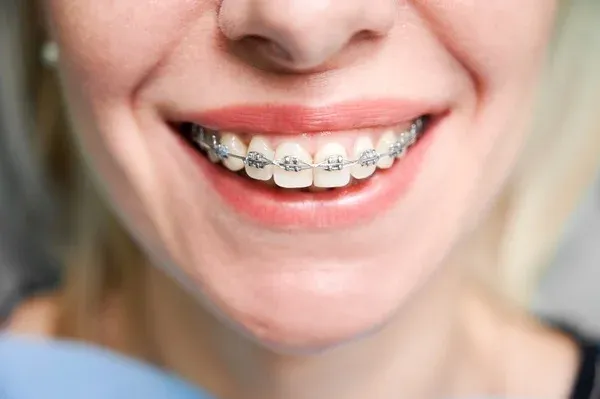Braces vs. Invisalign: Which Is Less Painful?
Dr. Hoss Abar
Deciding between braces and Invisalign often comes down to several factors, including aesthetics, treatment time, and comfort. One of the most common questions prospective orthodontic patients ask is: which option is less painful? To help you make an informed decision, this post dives into the differences in pain, comfort levels, and pain management techniques between braces and Invisalign.
Understanding the Pain of Orthodontic Treatment
Braces and Invisalign are designed to slowly shift your teeth into proper positions over time. This movement can cause some pressure and, therefore, slight pain or discomfort as your teeth and gums adjust to the movement. Everybody feels pain in a different way, but knowing what to expect with each kind of treatment will help you manage your expectations and the pain that comes with it.
Braces: Pain, Comfort, and Management
Braces, a tried-and-true orthodontic option for decades, have consistently delivered effective results. They consist of metal brackets adhered to the teeth, connected by a wire that applies pressure to reposition the teeth over time. Here's what to expect in terms of pain and comfort with braces.

Initial Discomfort
Having braces placed on is not as comfortable because the process of tightening the braces involves having some sort of object in the mouth. Most patients feel the worst discomfort in the first days or a week after getting braces. This initial discomfort is usually a throbbing, persistent discomfort caused by the pressure exerted by the braces and can be relieved by a painkiller recommended by your dentist.
Pain during adjustments
Braces need to be adjusted from time to time, more specifically, every four to eight weeks to tighten the wire for further movement. After each adjustment, the patient may feel a little soreness or tenderness in their teeth for a couple of days as the teeth adjust to the new pressure. It's important to remember that this discomfort is temporary and a sign that your treatment is progressing. Every adjustment tends to be as painful as the first fitting, but usually, the soreness is gone in a couple of days.
Soft Tissue Irritation
Braces have a tendency to rub against the inner cheeks, lips and tongue since these are the areas of the mouth that are most likely to come into contact with the metal brackets. This can cause some areas to become sore and even chaffed or develop small cuts. For those patients who develop some discomfort in the form of irritation between brackets and the soft tissues, orthodontic wax can be used to coat problem areas to minimize friction, but many patients experience this as a constant problem throughout the treatment process.
Braces – Pain Management Tips
- Use orthodontic wax: Waxing brackets can help minimize irritation.
- Rinse with salt water: Mouth sores due to braces can be eased using saltwater rinses.
- Eat soft foods after adjustments: After each adjustment, soft foods (like soups, mashed potatoes, and yogurt) are easier on sensitive teeth.
Invisalign: Pain, Comfort, and Management
Invisalign is an alternative to normal braces that are more discrete and can be worn and removed as needed. Unlike traditional braces, Invisalign utilizes clear plastic trays that are fabricated to fit perfectly over your teeth. The Invisalign trays are then replaced every two weeks to keep the gradual movement going on.
Initial Discomfort
When you start using Invisalign trays there is some discomfort which is normal. Because the trays are custom-made to fit the patient's teeth to apply pressure, most patients report a similar dull ache in the first few days. However, since there are no brackets or wires. Most people find that the soreness with each new set of trays is less than with braces.
Changing Trays
Invisalign works through a sequence of aligner trays, each of which is intended to move the teeth slightly further toward the desired position. It may be a little uncomfortable for a day or two because of the change in pressure on the teeth when a new set of trays is worn, but this discomfort is usually minimal.
Soft Tissue Comfort
Invisalign biggest selling point is that the trays are made from smooth plastic and are, therefore, much less abrasive on the mouth than metal brackets. This absence of metal parts also eliminates the possibility of having sharp edges or poking wires and makes Invisalign much more comfortable for those who have sensitive mouth tissue or sores.
Invisalign Treatment: Pain Management Tips
- Wear trays as directed: Compliance with wearing Invisalign for at least 20-22 hours daily as advised reduces the time of soreness.
- Switch trays before bed: Night time change can help one avoid the initial discomfort of the trays and go to sleep.
- Cold compresses: An external cold application to the area may help decrease the swelling if applied outside the mouth.

Comparing Comfort Levels
Braces
- Pros: Less range of motion; better suited to cases where a patient has severe alignment problems.
- Cons: Possible soft tissue inflammation; pain may persist after spinal manipulations; visibility.
Invisalign
- Pros: Less apparent; less number of soft tissue complications; pain is generally localized and lasts for not more than three days with each tray exchange.
- Cons: It must be worn as prescribed, and it is not for all orthodontic problems.
Managing Pain: Braces vs. Invisalign
The level of pain that people feel is different, but both braces and Invisalign are slightly uncomfortable as your teeth move in the right position. But with braces, pain control is usually directed towards the protection of the tissues inside the mouth particularly after adjustment. Invisalign, however, tends to have fewer problems with tissue irritation, but patients have to take painkillers for the pressure caused by new aligners.
Some Useful Recommendations for Both Choices
- Oral Hygiene: It is important to brush and floss in order not to develop sensitive gums and to avoid other oral complications that may worsen the discomfort.
- Diet: In both options you should take a softer diet to ease pressure on the affected teeth.
- Patience: This is true because pain levels usually reduce after some time as the mouth adapts to the cap.
Contact your Pinole dentist, Dr. Hoss Abar, DDS, MSD at Abar Orthodontics, to learn more about Braces vs. Invisalign.
Resource:
How to maintain dental hygiene with braces?
*This media/content or any other on this website does not prescribe, recommend, or prevent any treatment or procedure. Therefore, we highly suggest that you get the advice of a qualified dentist or other medical practitioners regarding your specific dental condition.*
More To Explore
About Us
We believe that every patient deserves to feel confident about their smile. Years of experience creating beautiful and flawless smiles.
Opening Hours:
Monday - Thursday: 8:00 AM - 5:00 PM
Friday: 8:00 AM - 12:00 PM
Saturday - Sunday: Closed
Abar Orthodontics, Pinole, CA
1500 Tara Hills Drive., Suite 204
Pinole, CA 94564
Abar Orthodontics, San Leandro, CA
145 East 14th street., #100
San Leandro, CA 94577
© 2025Abar Orthodontics | All rights reserved | Powered by:Vigorant, Inc.
